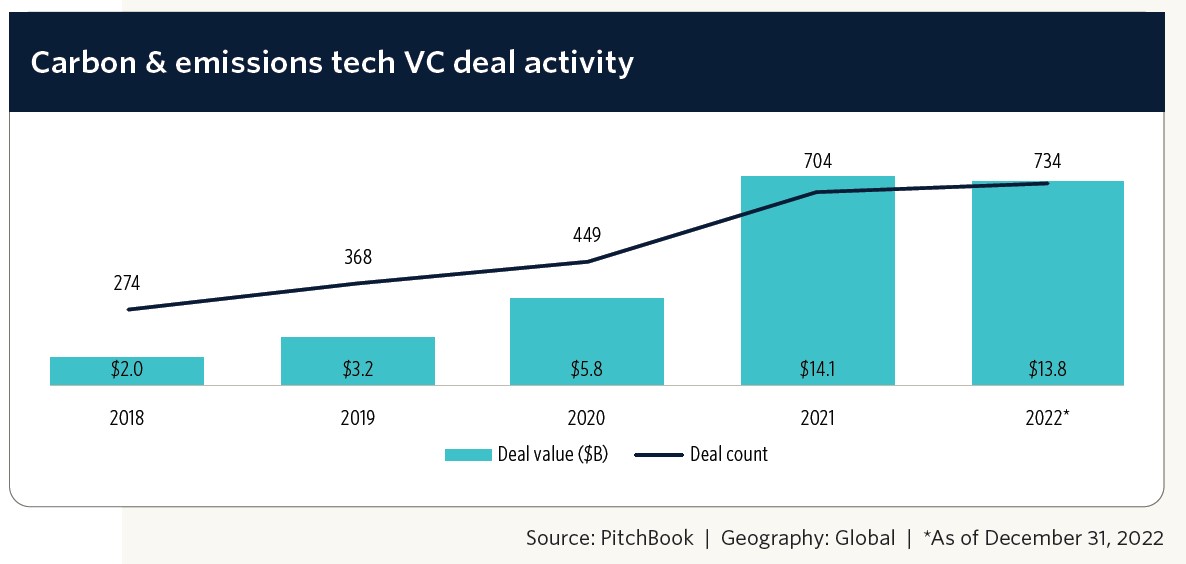Earth Day 2023: What to Know About Carbon-Capture Technologies
A look at this new frontier for investors, plus how to invest in clean energy.

The energy crisis of 2022 spotlighted the charms of carbon-capture technologies. These are solutions that help mitigate carbon dioxide emissions from sources such as power plants and factories and remove existing CO₂ from the atmosphere.
The promise of carbon capture gained attention in 2022 as global coal use expanded during the energy crisis and Russia reduced its production of natural gas. Coal contains more carbon than oil or gas and is the global energy system’s largest single source of carbon dioxide emissions by far. According to the International Energy Agency estimates, it rose by 1.2% in 2022, surpassing 8 billion tons in a single year for the first time in history.
The IEA expects coal use to remain robust in emerging Asia. That is why some governments have decided to accelerate development of carbon-capture technologies. Businesses and investors are also spying new opportunities.
Government Initiatives for Carbon Capture
Coal use puts at risk the European Union 2050 net-zero emissions target. Thus, governments are planning new initiatives to meet the target, including energy efficiency, renewable energies, and carbon capture.
Germany, in particular, has returned to coal to replace Russian natural gas but is interested in advancing carbon-capture technology. In the first week of 2023, the German and Norwegian governments agreed to cooperate in accelerating the deployment of carbon-capture and storage technologies.
In the EU, the European Commission proposed establishing an EU framework for the certification of carbon removal, thereby increasing confidence in carbon removal certificates.
Meanwhile, the United States passed the Inflation Reduction Act, which provides large investments in reducing carbon emissions and fighting climate change. In addition, in the fourth quarter of 2022, the U.S. launched four programs aiming to “help accelerate private-sector investment, spur advancements in monitoring and reporting practices for carbon management technologies, and provide grants to state and local governments to procure and use products developed from captured carbon emissions.”
Carbon-Capture Technologies and Venture Capital
Venture capital has already seen opportunities in carbon-capture technologies. According to PitchBook, in 2022, a difficult year for private markets, carbon and emissions technologies defied this trend. In 2022, total VC investment in areas including carbon capture, utilization, and storage; carbon accounting and fintech; industrial decarbonization; land use decarbonization; and built environment decarbonization was nearly identical to 2021. Deal count showed a slight increase in 2022, rising to 734 from 704 in 2021; the deal value decreased slightly to USD 13.8 billion from USD 14.1.

What Are Carbon-Capture Technologies?
Carbon capture, usage, and storage, aka CCUS, refers to a suite of technologies that enable the mitigation of CO₂ emissions from large point sources such as power plants, refineries, and other industrial facilities, or the removal of existing CO₂ from the atmosphere.
The CCUS process consists of three stages: capture, transport, and storage, or usage of CO₂. Once it has been captured, it is compressed into a liquid state, transported and injected into deep geological formations, to be permanently stored in depleted oil and gas reservoirs, coal beds, or deep saline aquifers.
Often, captured CO₂ can be used as an input for commercial products and services like cement and plastic. It can also be subject to part storage and part reuse.
Net-Zero Emissions Target
In the report “Net Zero by 2050. A Roadmap for the Global Energy Sector,” the IEA forecasts that carbon-capture volumes will “increase marginally over the next five years from the current level” of around 40 metric tons of CO₂ equivalent per year. Then comes “a rapid expansion over the following 25 years as policy action bears fruit. By 2030, 1.6 GT CO₂ per year is captured globally, rising to 7.6 [GT] CO₂ in 2050.” The IEA believes 95% of total CO₂ captured in 2050 will be in permanent geological storage and 5% used to provide synthetic fuels.

Venture Capital Plays a Key Role
Researchers are working to develop new technologies to capture CO₂. One example is the EU-funded Advanced Atmospheric Carbon-Capture Technology initiative. It has designed a new device for directly capturing CO₂ from the air. Installed directly in an industrial site or IT data center, the solution filters CO₂ from the air and uses vacuum and heat to regenerate the materials, producing pure CO₂.
To move from the prototype stage to implementation, these projects need funding, and private markets are an important source. Venture capitalists have shown an interest in carbon-capture technologies in the recent year. In the fourth quarter of 2022, for example, Svante, a Canada-based carbon-capture hardware company, raised USD 318.0 million, in a deal led by Chevron Technology Ventures, Chevron’s CVX business unit for the innovation.
Carbon-Capture Technology in the Public Markets
Some companies in the industry have already moved from private to public markets. Such is the case with LanzaTech Global LNZA, which debuted on the Nasdaq in mid-February 2023. Founded in 2005, it transforms waste carbon into materials such as sustainable fuels, fabrics, packaging, and other products. The company’s goal is to challenge and change the way the world uses carbon, enabling a new circular carbon economy where carbon is reused rather than wasted, skies and oceans are kept clean, and pollution becomes a thing of the past.
Another example is Origin Materials ORGN, which went public in February 2023. It is a carbon-negative materials company. The platform turns the carbon found in biomass into useful materials while eliminating the need for fossil resources and capturing carbon in the process. Carbon-negative material means removing more carbon than it emits into the atmosphere during its entire lifecycle.
Big Energy Companies Are Funding the Startup
In some cases, funding for startups pioneering carbon-capture technologies comes from big energy companies. In December 2022, Equinor Ventures, the innovation business unit of Norway’s Equinor EQNR, led a USD 12 million deal for Captura, which employs a patented electrodialysis technology, powered by renewable sources, to extract carbon dioxide from seawater before returning a stream of decarbonized water into the ocean. Founded in 2021, Captura is currently carrying out ocean trials of its technology as a pilot project. The company valuation is about USD 29 million (PitchBook data as of Dec. 28, 2022).
Investing in Clean Energy Technologies
Investors interested in the future technologies for reducing greenhouse gas emissions and transitioning to a low-carbon environment can look to clean energy and clean tech mutual funds and exchange-traded funds, which invest in companies that contribute to or facilitate the clean energy transition. This includes renewable energies such as wind, solar, hydroelectric, wave, and geothermal power along, with grid infrastructure improvements, transmission and distribution, energy storage, and innovative technologies such as carbon capture and storage.
The largest clean energy/tech fund in Europe is Vontobel Clean Technology, which has a Morningstar rating of Silver in the cheapest classes and Bronze and Neutral in the others (as of March 15, 2023).
“The investable universe is set by a thematic framework that has been in place since the strategy’s inception in 2008. Each potential investment should have at least 20% of its revenue or profit, although this exposure is typically much higher, related to one of six impact pillars: lifecycle management, resource-efficient industry, building technology, clean energy infrastructure, low-emission transportation, and clean water,” said Morningstar analyst Ronald van Genderen. “The strategy achieved a strong track record since inception in December 2008, but it tends to lag in down markets.”
The second-largest is L&G Clean Energy ETF RENW, which replicates a global index of clean energy stocks that operate at different levels of the value chain. The ETF has a Morningstar Quantitative Analyst Rating of GoldQ (as of March 27, 2023). A very competitive commission profile contributes to this rating.
Investors in this field should be aware of the fact that clean energy/tech funds are characterized as sector-specific, have typically concentrated portfolios, and often have a bias toward mid- and small-cap stocks.
The author or authors do not own shares in any securities mentioned in this article. Find out about Morningstar’s editorial policies.


/cloudfront-us-east-1.images.arcpublishing.com/morningstar/NNGJ3G4COBBN5NSKSKMWOVYSMA.png)
/cloudfront-us-east-1.images.arcpublishing.com/morningstar/6BCTH5O2DVGYHBA4UDPCFNXA7M.png)
/cloudfront-us-east-1.images.arcpublishing.com/morningstar/EBTIDAIWWBBUZKXEEGCDYHQFDU.png)